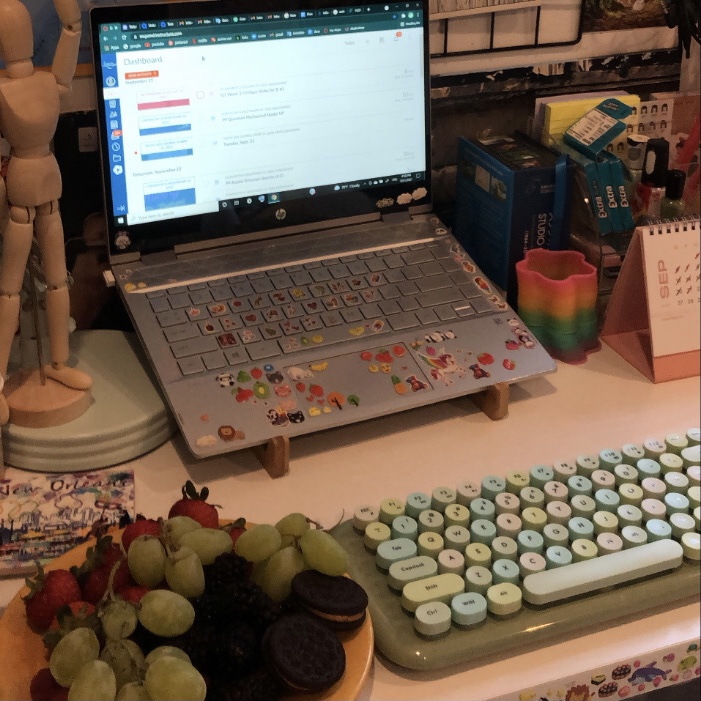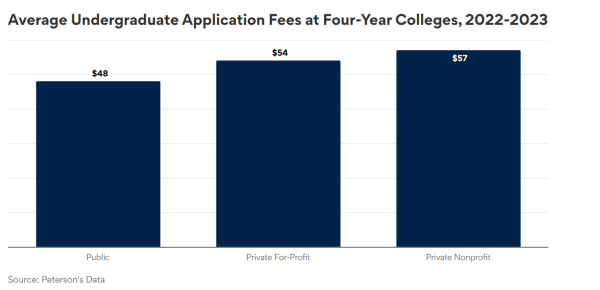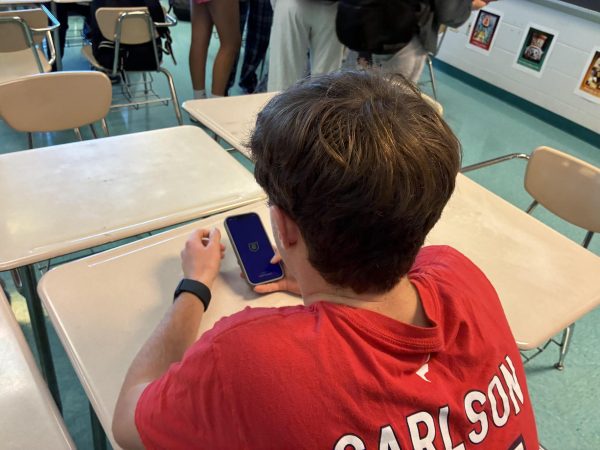Students can get organized, motivated to prepare for success
An example of a student’s desk organized to promote productivity and efficiency at home.
The transition from in-person school to online learning in 2020 had a major impact on students’ organization, motivation, routines, social interactions and mental health. The return to school this fall has been a relief for students, teachers and parents, however many middle and high school students feel academically and emotionally unprepared for the transition. In a recent survey by the nonprofit Junior Achievement of Arizona, Arizona’s Kold News said, “They spoke with over 1,000 students and found that over 30% of students in the 13-17 age group feel they will need additional emotional support this school year.”
During the transition to online learning last year, students faced several challenges that changed their daily routines and organization. This school, for example, changed its structure and schedule completely last year in order to adjust to online learning. School began nearly two hours later, allowing students to sleep in longer, and each day consisted of four class periods, as opposed to the eight periods students will attend each day this school year. Students also did not have scheduled class Zooms on Wednesdays and instead used the time to communicate with teachers, do work and get extra support.
Last year, students’ daily routines changed completely and with less pressure to do every assignment in class and on time, they mostly had to rely on themselves for schoolwork motivation. These changes had different outcomes for each student, but regardless of how successful they were during distanced learning, everyone had to adjust. Executive function coach Jessy Feinberg works with students to foster skills that promote their learning, such as planning, preparation, time management and task initiation. Feinberg said she thinks the biggest challenges facing students this year will be “maintaining a schedule, using digital and paper tools simultaneously, and adjusting to early wake-ups.”
Re-entering in-person school does not mean trying to pick up where we left off. Here are the organizational keys to success to prioritize this school year that aim to reduce the stress, frustration, and unpreparedness students are anticipating.
ROUTINES – Establishing routines at the beginning of the school year will be one of the most important factors in academic success and emotional well-being now that we’re back at school. The most prevalent example of a routine that should be consistent for everyone, not just students, is a sleep schedule.
It will be beneficial this year for students to plan ahead and figure out a sleep schedule that allows for at least eight hours of sleep each night, while leaving enough time for daily routines so they can balance priorities. Especially in an environment as academically demanding as this one, high schoolers tend to have a lot on their plates, and it’s impossible to be successful for students unprepared to juggle.
ORGANIZATIONAL SYSTEMS – While it may seem obvious, using the right organizational systems, online and off, will be a crucial part of getting organized for students this year. “In the online learning world, students had to adjust to organizing their work into digital spaces such as Canvas and Google Drive. While many students are regularly using technology, it is very different to be an online learner- students were not used to looking in many different places for their assignments and maintaining a digital calendar or even their email. Now that students are back to in-person learning experiences, they are transitioning back to paper worksheets in combination with some digital files. This hybrid of assignments is a tough adjustment- especially since students are nearly two grades older than they were the last time they used paper,” Feinberg said.
In-person learning means adjusting to use both physical and online organizational systems because instead of storing everything on Drive, students will need a backpack, notebooks, folders, and binders to keep track of assignments. Different organizational systems and tactics work differently for everyone. To find out what works for you, you should first recognize how your brain responds to different systems by reviewing how systems you’ve used in the past were successful or unsuccessful. Once you’re familiar with your organizational strengths and weaknesses, as well as what your brain responds positively and negatively to, you’ll be better equipped to prevent unnecessary stress and frustration in your life in and out of school.
INCENTIVES – Another challenge students may face transitioning from online school is balancing motivation and stress. For many students, being in person will turn school from a low-pressure environment, in which it was easy to lose concentration and motivation, to a high-pressure environment where students will be pushed more by teachers and peers to maintain concentration, motivation, and punctuality or risk falling grades. While the increased pressure may motivate students, it will likely be difficult to unlearn more than a year’s worth of bad habits developed by students’ lack of motivation during distanced learning.
Students may struggle with the motivation and time management skills required to succeed at school in person. According to a report from James Cook University, these struggles under increased pressure may lead to other issues like panic and procrastination. The motivation that stems from negative pressures and stressors can drive students to get work done, but according to the US National Library of Medicine, too much negative stress (or distress) can be detrimental to students’ health.
Creating positive pressure by incentivizing studying and assignments can help students overcome and avoid a lack of motivation. Incentives provide people with intrinsic motivation or an internal drive for personal satisfaction, enjoyment and benefit through an extrinsic method. A simple and effective way to incentivize assignments for students is to set a goal and a reward for the goal, whether short-term or long-term. An incentive could range anywhere from a few minutes of screen time after completing an assignment to a trip to a fancy restaurant at the end of a semester.
SUPPORT SYSTEMS – One of the most important issues to consider when discussing academic success during the return to school this year is students’ mental health. High school students’ mental health has been uniquely affected by the pandemic and online learning, which brought with them increased isolation, anxiety and frustration that will have a lasting effect on teens’ developing brains. The American Psychological Association (APA) reports 81% of Gen Z teens (ages 13–17) have experienced more intense stress during the COVID-19 pandemic. According to the CDC, “Beginning in April 2020, the proportion of children’s mental health-related Emergency Department visits increased and remained elevated through October. Compared with 2019, the proportion of mental health-related visits for children aged 5–11 and 12–17 years increased approximately 24% and 31%, respectively.”
For teens struggling with mental health during the pandemic, the transition back to in-person school may be beneficial, but it may also prove especially difficult. This is why it is more important than ever that students have a solid support system at school and in their lives outside of school. Whether it’s family, teachers or a counselor, students should remember this year to get to know the support systems around them and reach out for help if they need it.
Your donation will support the student journalists of Thomas S. Wootton High School. Your contribution will allow us to purchase equipment and cover our annual website hosting costs.
Senior Isaac Muffett is the opinions editor in his fourth year on the Common Sense staff. When he's not writing or researching, he spends his free time...






![Editors-in-Chief Ahmed Ibrahim, Helen Manolis, Cameron Cowen, Alex Grainger, Emory Scofield, Hayley Gottesman, Rebekah Buchman and Marley Hoffman create the first print magazine of the year during the October press days. “Only a quarter of the schools in MCPS have programs that are like ours, a thriving, robust program. That makes me really sad. This is not just good for [the student journalists] to be doing this, it’s good for the entire community. What [student journalists] provide to the community is a faith in journalism and that continues for their lifetimes," Starr said.](https://woottoncommonsense.com/wp-content/uploads/2025/10/wmpoFTZkCPiVA3YXA4tnGoSsZ4KmnKYBIfr18p3l-450x600.jpg)
